 W
WLike many other Western nations, Germany suffered the economic effects of the Great Depression with unemployment soaring around the Wall Street Crash of 1929. When Adolf Hitler became Chancellor of Germany in 1933, he introduced policies aimed at improving the economy. The changes included privatization of state industries, autarky and tariffs on imports. Weekly earnings increased by 19% in real terms from 1933 to 1939, but this was largely due to employees working longer hours, while the hourly wage rates remained close to the lowest levels reached during the Great Depression. In addition, reduced foreign trade meant rationing in consumer goods like poultry, fruit, and clothing for many Germans.
 W
WThe Angora project or Angora rabbit project was a Nazi SS endeavor in cuniculture during World War II that bred Angora rabbits to provide Angora wool and fur, as well as meat. The Angora rabbit's hair and pelt is known for strength and durability, and it was also "associated with luxurious evening wear, [and] would be an elegant solution for keeping SS officers and the German military warm and able to endure rough wartime conditions". Angora rabbits were raised in Nazi concentration camps, including Auschwitz, Buchenwald, Dachau, and Trawniki.
 W
WArbeitseinsatz was a forced labour category of internment within Nazi Germany during World War II. When German men were called up for military service, Nazi German authorities rounded up civilians to fill in the vacancies and to expand manufacturing operations. Some labourers came from Germany but exponentially more from roundups (łapanka) in the German-occupied territories. Arbeitseinsatz was not restricted to the industry sector and to arms producing factories; it also took place, for example, in the farming sector, community services, and even in the churches.
 W
WArbeitslager is a German language word which means labor camp. Under Nazism, the German government used forced labor extensively, starting in the 1930s but most especially during World War II. Another term was Zwangsarbeitslager.
 W
WBaudienst, full name in German Baudienst im Generalgouvernement, was a forced labour organization created by Nazi Germany in the General Government territory of occupied Poland during World War II. Baudienst was subordinate to the Reichsarbeitsdienst.
 W
WBromberg Dynamit Nobel AG Factory also known as Bromberg DAG AG Factory or DAG Fabrik Bromberg was one of the largest arms factory of Dynamit Nobel during the Third Reich: covering 23 square kilometres (8.9 sq mi), it was the second most extensive DAG factory at the time, after the 35 square kilometres (14 sq mi) Kombinat DAG Alfred Nobel Krzystkowice. Operating from 1939 to 1945 in the south-eastern Bydgoszcz forest, DAG Fabrik Bromberg produced propellants and explosives and realized ammunition handloading.
 W
WThis is a list of the largest companies of Nazi Germany by employees in 1938.
 W
WCouncils of Trust were established in businesses and companies with more than 20 employees in Nazi Germany following the introduction of the Labour organization law of 20 January 1934. They served as the only representation of employees to the “factory leader” in order to increase mutual trust within the factory community. Councillors were elected by secret ballots, but the list of candidates was prepared by the factory leader and the German Labour Front overseer. The councils did not play an active role in industrial relations, except to serve as a platform for discussing working conditions regulated in the “factory code of rules”.
 W
WA community of factory workers or a business community comprised the owner, management and work force in businesses and companies in Nazi Germany in accordance with the leader principle. The owner/manager was called “main leader” while the employees were considered to be followers. In order to promote a climate of mutual trust and understanding a Council of Trust had to be established under the Labour organization law. This council was elected from a list of candidates set up by the main leader for the factory workers or business community and the German Labour Front overseer. In accordance with Nazi ideology, foreigners and members of minorities considered unworthy of trust, could not be part of the factory community.
 W
WFactory leader was the term introduced by Labour organization law of 20 January 1934 for the owner, entrepreneur or manager of a business or company. Factory leaders and their “followers” formed the “factory community”, replicating the national community in accordance with the leader principle. The term was also applied to owners and tenants of farms.
 W
WForced labor was an important and ubiquitous aspect of the Nazi concentration camps which operated in Nazi Germany and German-occupied Europe between 1933 and 1945. It was the harshest and most inhumane part of a larger system of forced labor in Nazi Germany.
 W
WThe use of slave and forced labour in Nazi Germany and throughout German-occupied Europe during World War II took place on an unprecedented scale. It was a vital part of the German economic exploitation of conquered territories. It also contributed to the mass extermination of populations in occupied Europe. The Germans abducted approximately 12 million people from almost twenty European countries; about two thirds came from Central Europe and Eastern Europe. Many workers died as a result of their living conditions – extreme mistreatment, severe malnutrition, and worse tortures were the main causes of death. Many more became civilian casualties from enemy (Allied) bombing and shelling of their workplaces throughout the war. At its peak the forced labourers constituted 20% of the German work force. Counting deaths and turnover, about 15 million men and women were forced labourers at one point during the war.
 W
WThe following is a list of aircraft production by Germany during World War II by type and year. Note that some figures may not be accurate, and it is not comprehensive. Aircraft variants of different roles are listed separately. Related types are listed next to each other; see RLM aircraft designation system for an explanation.
 W
WThis article lists production figures for German armored fighting vehicles during the World War II era. Vehicles include tanks, self-propelled artillery, assault guns and tank destroyers.
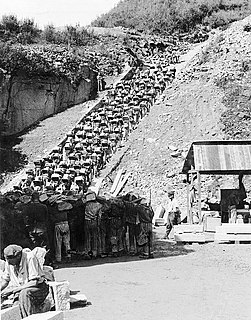 W
WGerman Earth and Stone Works was an SS-owned company created to procure and manufacture building materials for state construction projects in Nazi Germany. DEST was a subsidiary company of Amtsgruppe W of SS Main Economic and Administrative Office (WVHA). Both Amt. W and the WVHA were headed by Waffen-SS generals Oswald Pohl and Georg Lörner.
 W
WThe German Labour Front was the labour organisation under the Nazi Party which replaced the various independent trade unions in Germany during Adolf Hitler's rise to power.
 W
WGerman rearmament was a policy and practice of rearmament carried out in Germany during the interwar period (1918–1939), in violation of the Treaty of Versailles. It began on a small, secret, and informal basis shortly after the treaty was signed, but it was openly and massively expanded after the Nazi Party came to power in 1933.
 W
WThe German–Soviet Border and Commercial Agreement, signed on January 10, 1941, was a broad agreement which settled border disputes, and continued raw materials and war machine trade between the Soviet Union and Nazi Germany. The agreement continued the countries' relationship that started in 1939 with the Molotov–Ribbentrop Pact, which contained secret protocols that divided Eastern Europe between the Soviet Union and Germany. The relationship had continued with the subsequent invasions by Germany and the Soviet Union of that territory. The agreement contained additional secret protocols, settling a dispute regarding land in Lithuania, which was had been split between both countries. The agreement continued the Nazi–Soviet economic relations that had been expanded by the 1939 German–Soviet Commercial Agreement and the more comprehensive 1940 German–Soviet Commercial Agreement.
 W
WThe 1940 German-Soviet Commercial Agreement was an economic arrangement between the Soviet Union and Nazi Germany signed on February 11, 1940. In it the Soviet Union agreed in the period from February 11, 1940 to February 11, 1941, in addition to the deliveries under German–Soviet Commercial Agreement, signed on August 19, 1939 to deliver commodities to the value of 420 to 430 million Reichsmarks.
 W
WGranitwerke Mauthausen was one of the names used by the DEST company for its branch based in Sankt Georgen an der Gusen and which exploited the slave manpower confined in certain subcamps of the Mauthausen-Gusen concentration camp system: Gusen I, Gusen II, Gusen III, and Mauthausen.
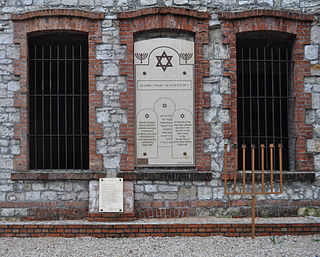 W
WHASAG was a German metal goods manufacturer founded in 1863. Based in Leipzig, it grew from a small business making lamps and other small metal products by hand into a large factory and publicly traded company that sold its wares in several countries. During the Second World War, Hasag became a Nazi arms-manufacturing conglomerate with dozens of factories across German-occupied Europe using slave labour on a massive scale. Tens of thousands of Jews from Poland, and other prisoners, died producing munition for Hasag.
 W
WIndustriewerke Ludwigsfelde is an automotive factory in Ludwigsfelde in Brandenburg, just south of Berlin in Germany. The factory is part of Daimler AG and since 1991 it has made Mercedes-Benz vans. It is also the producer of the Multicar line of automobiles.
 W
W"Italian Military Internees" was the official name given by Germany to the Italian soldiers captured, rounded up and deported in the territories of Nazi Germany in Operation Achse in the days immediately following the World War II armistice between Italy and Allied armed forces.
 W
WAlfried Felix Alwyn Krupp von Bohlen und Halbach, often referred to as Alfried Krupp, was a German industrialist, a competitor in Olympic yacht races, and a member of the Krupp family, which has been prominent in German industry since the early 19th century. He was convicted after World War II of crimes against humanity for the genocidal manner in which he operated his factories ; served three years in prison until being pardoned.
 W
WMax Heiliger was a false identity created during the Nazi era to establish bank accounts for laundering and fencing valuables stolen from those killed in the Holocaust. Additionally, stolen artwork and furniture from vacated homes of Holocaust victims was collected separately and auctioned; the resulting funds were then funneled into the same accounts. Its creation was authorized by Reichsbank president Walther Funk in a secret arrangement with Schutzstaffel leader Heinrich Himmler.
 W
WItaly v France, United Kingdom and United States was a case decided by the International Court of Justice (ICJ) in 1954, and part of a long-running dispute over the fate of Nazi gold that was originally seized from Rome. The ICJ held that it had no jurisdiction to adjudicate the case.
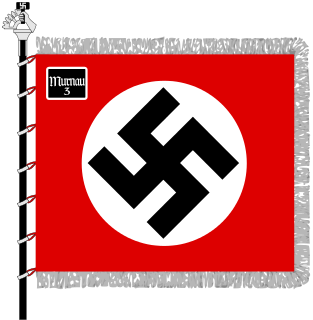 W
WThe National Socialist Factory Cell Organization was a workers organization in Nazi Germany.
 W
WNazi plunder was the stealing of art and other items which occurred as a result of the organized looting of European countries during the time of the Third Reich by agents who acted on behalf of the ruling Nazi Party of Germany. The looting of Jewish property was a key part of the Holocaust. The plundering was carried out from 1933, beginning with the seizure of the property of German Jews, until the end of World War II, particularly by military units which were known as the Kunstschutz, although most of the plunder was acquired during the war. In addition to gold, silver and currency, cultural items of great significance were stolen, including paintings, ceramics, books and religious treasures.
 W
WAfter the Nazis rose to power in Germany in 1933, relations between Nazi Germany and the Soviet Union began to deteriorate rapidly. Trade between the two sides decreased. Following several years of high tension and rivalry, the two governments began to improve relations in 1939. In August of that year, the countries expanded their economic relationship by entering into a Trade and Credit agreement whereby the Soviet Union sent critical raw materials to Germany in exchange for weapons, military technology and civilian machinery. That deal accompanied the Molotov–Ribbentrop Pact, which contained secret protocols dividing central Europe between them, after which both Nazi forces and Soviet forces invaded territories listed within their "spheres of influence".
 W
WOstarbeiter was a Nazi German designation for foreign slave workers gathered from occupied Central and Eastern Europe to perform forced labor in Germany during World War II. The Germans started deporting civilians at the beginning of the war and began doing so at unprecedented levels following Operation Barbarossa in 1941. They apprehended Ostarbeiter from the newly-formed German districts of Reichskommissariat Ukraine, District of Galicia, and Reichskommissariat Ostland. These areas comprised German-occupied Poland and the conquered territories of the Soviet Union. According to Pavel Polian, over 50% of Ostarbeiters were formerly Soviet subjects originating from the territory of modern-day Ukraine, followed by Polish women workers. Eastern workers included ethnic Ukrainians, Poles, Belarusians, Russians, Armenians, Tatars, and others. Estimates of the number of Ostarbeiter range between 3 million and 5.5 million.
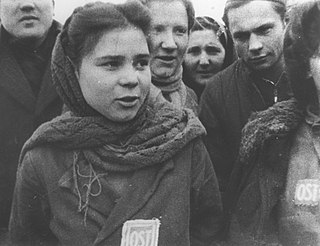 W
WOstindustrie GmbH was one of many industrial projects set up by the Nazi German Schutzstaffel (SS) using Jewish and Polish forced labor during World War II. Founded in March 1943 in German-occupied Poland, Osti operated confiscated Jewish and Polish prewar industrial enterprises, including foundries, textile plants, quarries and glassworks. Osti was headed by SS-Obersturmführer Max Horn, who was subordinated directly to Obergruppenführer Oswald Pohl of the SS Main Economic and Administrative Office. At its height, some 16,000 Jews and 1,000 Poles worked for the company, interned in a network of labor and concentration camps in the Lublin District of the semi-colonial General Government territory.
 W
WPrivate sector participation in Nazi crimes was extensive and included widespread use of forced labor in Nazi Germany and German-occupied Europe, confiscation of property from Jews and other victims by banks and insurance companies, and the transportation of people to Nazi concentration camps and extermination camps by rail. After the war, companies sought to downplay their participation in crimes and claimed that they were also victims of Nazi totalitarianism. However, the role of the private sector in Nazi Germany has been described as an example of state-corporate crime.
 W
WThe Reich Labour Service was a major organisation established in Nazi Germany as an agency to help mitigate the effects of unemployment on the German economy, militarise the workforce and indoctrinate it with Nazi ideology. It was the official state labour service, divided into separate sections for men and women.
 W
WThe Reichsbank was the central bank of the German Reich from 1876 until 1945.
 W
WThe Reichsmark was the currency of Germany from 1924 until 20 June 1948 in West Germany, where it was replaced with the Deutsche Mark, and until 23 June 1948 in East Germany, where it was replaced by the East German mark. The Reichsmark was subdivided into 100 Reichspfennigs. The Mark is an ancient Germanic weight measure, traditionally a half pound, later used for several coins; whereas Reich, comes from the official name for the German state from 1871 to 1945, Deutsches Reich.
 W
WReichswerke Hermann Göring was an industrial conglomerate in Nazi Germany. It was established in July 1937 to extract and process domestic iron ores from Salzgitter that were deemed uneconomical by the privately held steel mills. The state-owned Reichswerke was seen as a vehicle of hastening growth in ore mining and steel output regardless of private capitalists' plans and opinions, which ran contrary to Adolf Hitler's strategic vision. In November 1937, Reichsminister of Aviation Hermann Göring obtained unchecked access to state financing and launched a chain of mergers, diversifying into military industries with the absorption of Rheinmetall. Göring himself supervised the Reichswerke but did not own it in any sense and did not make personal profit from it directly, although at times he withdrew cash for personal expenses.
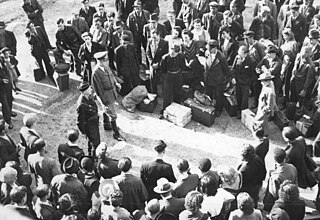 W
WThe Service du travail obligatoire was the forced enlistment and deportation of hundreds of thousands of French workers to Nazi Germany to work as forced labour for the German war effort during World War II.
 W
WThe Sturm Cigarette Company was a cigarette company created by the Nazi Party's Sturmabteilung (SA). The sale of its cigarettes provided the SA with operating funds and a channel for political messaging. Coercion and violence were used to increase sales.
 W
WOrganisation Todt (OT) was a civil and military engineering organisation in Nazi Germany from 1933 to 1945, named for its founder, Fritz Todt, an engineer and senior Nazi. The organisation was responsible for a huge range of engineering projects both in Nazi Germany and in occupied territories from France to the Soviet Union during World War II. It became notorious for using forced labour. From 1943 until 1945 during the late phase of the Third Reich, OT administered all constructions of concentration camps to supply forced labour to industry.
 W
WVolkswagenwerk Braunschweig is a factory site for Volkswagen automobile parts in Braunschweig, Germany. Production started on 1938-02-23 for manufacturing steering components of „KdF-Wagen" and tools for Junkers Flugzeug- und Motorenwerke in Dessau. Until today, only components for vehicles of VW Group are produced, such as running gears, axles, shock absorbers, brake parts and all pedals.
 W
WWehrwirtschaftsführer (WeWiFü) were, during the time of Nazi Germany (1933–1945), executives of companies or big factories called 'rüstungswichtiger Betrieb' . Wehrwirtschaftsführer were appointed, starting 1935, by the 'Wehrwirtschafts- und Rüstungsamt' being a part of the Oberkommando der Wehrmacht (OKW), that was pushing the build-up of arms for the Wehrmacht. The purpose of the appointment was to bind them to the Wehrmacht and to give them a quasi-military status.